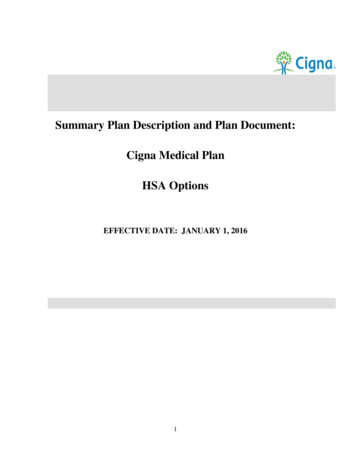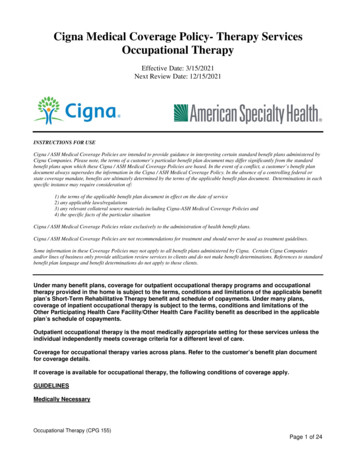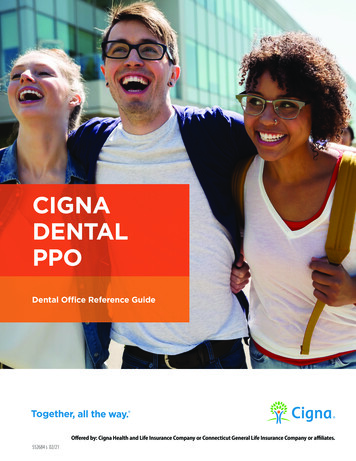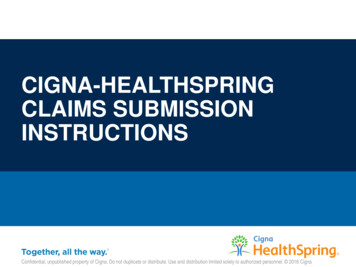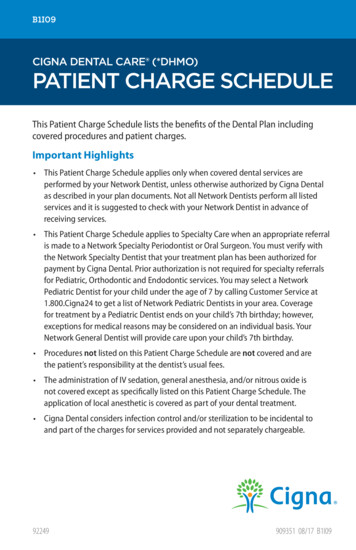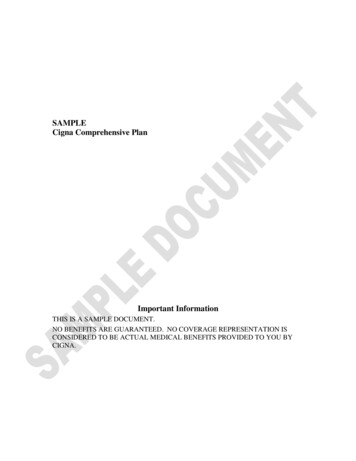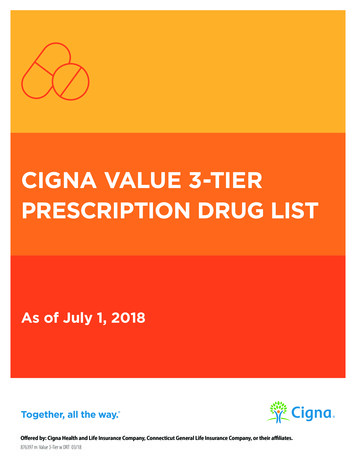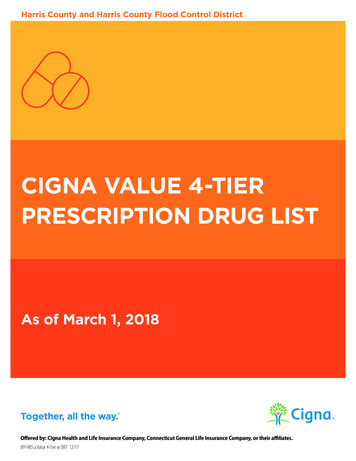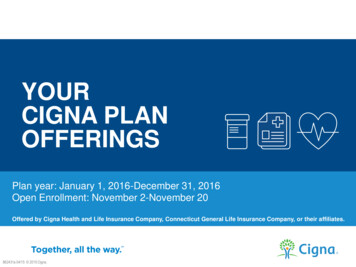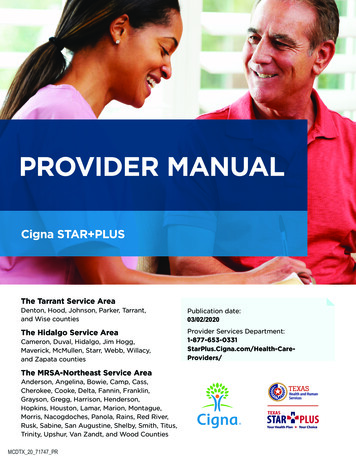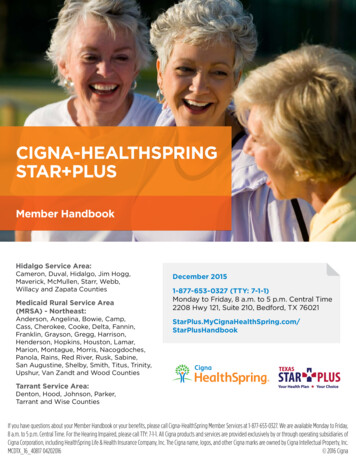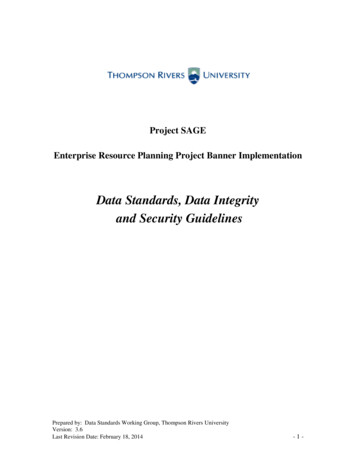
Transcription
CIGNA STANDARDS ANDGUIDELINES/MEDICALNECESSITY CRITERIAFor Treatment of Mental Health DisordersApril 2020
Table of ContentsForeword . 2Core Principles . 3Mental Health . 5Acute Inpatient Mental Health Treatment for Adults . 6Residential Mental Health Treatment for Adults . 9Partial Hospital Mental Health Treatment for Adults . 14Intensive Outpatient Mental Health Treatment for Adults . 19Mental Health Treatment for Children and Adolescents . 23Acute Inpatient Mental Health Treatment for Children and Adolescents . 24Residential Mental Health Treatment for Children and Adolescents . 27Partial Hospital Mental Health Treatment for Children and Adolescents . 33Intensive Outpatient Mental Health Treatment for Children and Adolescents . 37Outpatient Treatment . 42Outpatient Behavioral Health Treatment . 43Telehealth Services . 46Substance Use Disorders Treatment . 48Eating Disorders Treatment. 50Acute Inpatient Eating Disorders Treatment. 51Residential Eating Disorders Treatment . 55Partial Hospital Eating Disorders Treatment . 59Intensive Outpatient Eating Disorders Treatment . 64Behavioral Health Assessment and Treatment Procedures. 69Crisis Stabilization . 70Electroconvulsive Therapy (ECT) . 73Psychological Testing . 76Neuropsychological Testing . 78References . 79Editorial Staff .82Editorial Board . 831
ForewordTwelve years have passed since The Federal Mental Health Parity and Addiction Equity Act became law in 2008. Thehealth care industry has evolved and increased in complexity over that time. There is increased benefit coverage forpeople with mental health and substance use conditions, and regulations have brought about changes in the way healthcare coverage is managed. As a result, some of the barriers that individuals have faced in obtaining the proper diagnosisand essential treatment for their condition have been addressed; however, we continue to be faced with a shortage ofmental health and substance use disorder services and clinicians in many areas of the country. And, despite Americanshaving a more sophisticated understanding of behavioral health issues, along with an increased awareness throughexposure on television and in the media, studies show that there continues to be significant social stigma attached topeople with mental illness and substance use disorders.With over 150 million Americans covered under employer-based insurance, and millions more covered through the stateand federal exchanges, it is essential that we all work together to take advantage of the advances and opportunitiesbrought by these regulations. We all share the desire to see every individual receive the best care possible. In doing so,we have the responsibility to collaborate with one another to leverage each individual’s health care benefits and to deliverthe most effective care in the most appropriate setting at the right time.Several key areas are necessary to consider as we engage in a cooperative and inclusive dialogue, including variations instandards of care across the country and health care disparities for people with mental health and substance usedisorders. Also, there are still significant gaps in service between mental health clinicians and general medical clinicians,and current privacy regulations impede our ability to fully share important clinical information with other treating clinicians.This is important not only as we attempt to provide an integrated and holistic health care experience for individuals, butthis also perpetuates the stigma associated with behavioral health and substance use disorders.With all of the complexity in health care, we support practitioners in exercising their professional judgment to makeinformed decisions and offer quality care. We also support a consistent application of evidence based guidelines toenhance clinical judgment and to ensure that treatment includes consideration of the practices that have been shown tobe most effective for mental health and substance use disorders. In keeping with this commitment, we have adopted theASAM Criteria for Substance Use Disorders and developed our Standards and Guidelines - Medical Necessity Criteria forTreatment of Mental Health Disorders. These Criteria are intended to be working documents to help set expectations andfacilitate a shared responsibility. These Criteria do not replace clinical judgment, and we recognize that they requireadaptation to the unique situations of each individual patient, as well as to relevant state regulations and licensingstandards.We hope this document will prove to be a worthwhile resource, and we thank our practitioners for the outstanding workthey do in helping individuals to live healthier, more balanced lives. At Cigna, we support open dialogue with our cliniciancommunity and all of our customers. We also welcome ongoing feedback to find ways that we can all work together tobetter serve you.Douglas Nemecek, M.D., M.B.A.Chief Medical Officer – Behavioral Health2
Core PrinciplesGeneral OverviewCigna is committed to helping the people we serve improve their health, well-being, and peace of mind. That is ourmission. We realize that this is not possible without the understanding that mental health is equally important to physicalhealth. There is a growing awareness across the United States of the influence of mental health and substance useconditions and the burden they place on individuals, families, and society. We believe that effective treatment for anyillness must address behavioral health and physical health together. In fact, effective mental health and substance usedisorder treatment is a cornerstone to driving holistic health and well-being. Taking this holistic view helps the people weserve be more productive at work, and more importantly, more productive at home with their families and in theircommunities.At Cigna, we strongly believe that the core principle that guides mental health and substance use disorder care is thataccess to high quality care should be assured for everyone. This is true regardless of the diagnosis, treatment setting,type of clinician, geographic location, the sex, race, age, or disability of the individual seeking care. According to theInstitute of Medicine report, “Improving the Quality of Health Care for Mental and Substance-Use Conditions,” there aresix dimensions that need to be addressed in achieving high quality care for patients. 1 Quality mental health and substanceuse disorder care needs to be: safe, effective, patient-centered, timely, efficient, and equitable. Acceptance of these sixdimensions of care is essential to delivering the most effective and most appropriate care to every patient. This Institute ofMedicine report also identifies the importance of patient care being coordinated over time and across people, functions,activities, and treatment settings so that each patient receives the maximum benefit from their treatment services. It isfrom this core principle that Cigna has adopted the ASAM Criteria for Substance Use Disorders and developed ourStandards and Guidelines - Medical Necessity Criteria for Treatment of Mental Health Disorders.Medical Necessity CriteriaCigna begins with evidence-based guidelines as the basic platform to define established standards of effective care.Scientific evidence is the vital element in the development of an informed decision-making process for patients and theirclinicians. The Surgeon General2,3, the President’s New Freedom Commission on Mental Health4, and the Institute ofMedicine1 have all produced reports that highlight the importance of improving the dissemination and adoption ofevidence-based practices. Effective treatment is ultimately linked to the consistent use of these evidence-based clinicalpractices and the ability of mental health and substance use disorder clinicians to effectively execute these therapies.Effective April 25, 2020, Cigna has adopted the ASAM Criteria, developed and published by the American Society ofAddiction Medicine, as the criteria we will use to determine medical necessity for Substance Use Disorder treatment, dueto their acceptance as the best, national, evidence-based standards for substance use disorder care. Cigna has alsoadopted nationally developed and published clinical practice guidelines of the American Psychiatric Association and theAmerican Association of Pediatrics due to their acceptance as the best of evidence-based practice for mental healthdisorders. These evidence-based clinical practices then serve as a decision support tool to help define the mostappropriate treatment setting and help assure consistency of care for each individual.In the development of our Medical Necessity Criteria for Treatment of Mental Health Disorders, Cigna has listened to themessages and feedback from patients, families, advocacy groups (MHA and NAMI), professional associations (AmericanPsychiatric Association, American Academy of Child and Adolescent Psychiatrists, American Psychological Association,and the Association for Ambulatory Behavioral Healthcare), regulatory bodies, psychiatrists, psychologists, and therapistsacross the country. We have incorporated the strongest, evidence-based points into our Mental Health Criteria, and theyreflect the mutual consensus of all of our stakeholders.Cigna is proud to keep the development process of our Mental Health Criteria open and transparent to the public. Weappreciate the active and meaningful role that patients, clinicians, and advocates have in determining how the scientificevidence is applied in our Mental Health Criteria. In addition to listening to their input, we have also worked to write ourMental Health Criteria in words that everyone can understand. Our Criteria are only of value when we can have open,3
clear, and complete discussions, and when individuals and their clinicians can understand and use the Criteria in theirbehavioral healthcare decision making. Along with the ASAM Criteria, these Criteria then become a working document tohelp set expectations and to facilitate a joint working relationship and shared responsibility between Cigna and mentalhealth and substance use disorder clinicians.It is important to note that these Criteria (ASAM Criteria and Cigna Standards and Guidelines – Medical Necessity Criteriafor Mental Health Disorders) are adopted and established as national standards. However, we recognize that manystates have established state-specific standards and expectations for care, and have codified these into state laws,regulations and licensing rules. Sometimes specific levels of care or programs are not available in certain markets. Cignaalways approaches the application of these Criteria allowing for exceptions to be made to comply with state regulatoryand licensing standards.Cigna believes that all treatment decisions that are made in alignment with these Criteria must be first and foremostclinically based. Care must be patient-centered and take into account the individuals’ needs, clinical and environmentalfactors, and personal values. These Criteria do not replace clinical judgment, and every treatment decision must allow forthe consideration of the unique situation of the individual. In this way, these Criteria promote advocacy for the patient andenhance the collaboration between Cigna and clinicians to achieve optimal, patient-centered outcomes. They alsopromote consistent communication and coordination of care from one treatment setting to the next. Finally, these Criteria,and their application, are always governed by the terms of each individual customer’s benefit plan and in accordance withapplicable federal and state laws and regulations.Providing every individual with access to quality, evidence-based, patient-centered care is the core tenet of our approachat Cigna. It is from this approach that the ASAM Criteria and our Standards and Guidelines - Medical Necessity Criteriafor Treatment of Mental Health Disorders help drive improvements in holistic health care and ensure consistent,meaningful outcomes for everyone.Douglas Nemecek, M.D., M.B.A.Chief Medical Officer – Behavioral Health1Improvingthe Quality of Health Care for Mental and Substance Use Conditions, Institute of Medicine, Committee on Crossing theQuality Chasm: Adaptation to Mental Health and Addictive Disorders, Board of Health Care Services. Washington DC: NationalAcademies Press, 2005.2MentalHealth: A Report of the Surgeon General. Office of the Surgeon General, Department of Health and Human Services.Washington DC, 1999.3FacingAddiction in America. The Surgeon General’s Report on Alcohol, Drugs, and Health. Office of the Surgeon General,Department of Health and Human Services. Washington DC, 2016.4Achievingthe Promise: Transforming Mental Health Care in America, The President’s New Freedom Commission on Mental Health,Department of Health and Human Services. Washington DC, 2003.4
Mental HealthTreatment for AdultsSECTION I.5
Acute Inpatient Mental Health Treatment for AdultsStandards and GuidelinesMedical Necessity – In considering coverage for any level of care, all elements of Medical Necessity must be met asspecifically outlined in the individual’s benefit plan documents. Although benefit plan definitions of MedicalNecessity/Medically Necessary vary to some degree, they commonly require the service or supply to be:In accordance with the generally accepted standards of medical practice,Clinically appropriate, in terms of type, frequency, extent, site and duration, and considered effective for thepatient's illness, injury or disease; and,Not primarily for the convenience of the patient or Physician, and not more costly than an alternative service orsequence of services at least as likely to produce equivalent therapeutic or diagnostic results as to the diagnosisor treatment of that patient's illness, injury or disease.Examples of Cigna standard definitions of Medical Necessity can be located at: nitions.Description – Acute Inpatient Mental Health Treatment for Adults is utilized when the following servicesare needed:Around-the-clock intensive, psychiatric/medical care and onsite 24 hour nursing care including continuousobservation, monitoring and intervention, as well as, administration of medications as clinically indicated.Acute management to prevent harm or significant deterioration of functioning and to ensure the safety of theindividual and/or others,Daily monitoring of medication effects and side effects; and,A contained environment for specific treatments that could not be safely done in a non-monitored setting.Admission Considerations for Acute Inpatient Mental Health Treatment for Adults:Within 24 hours prior to admission, there has been a face-to-face individual assessment by a licensed behavioralhealth clinician, with training and experience in the assessment and treatment of acute mental health disordersconsistent with the age and problems of the individual. This assessment includes a clinically-basedrecommendation for the need for this level of care and includes family/significant others as clinically indicated.Alternative less restrictive levels of care are considered and referrals are attempted as appropriate.Expectations for Acute Inpatient Mental Health Treatment for Adults:A documented diagnosis of a mental health disorder, per the most recent version of the Diagnostic and StatisticalManual of Mental Disorders, and evidence of acute distress/impairment.Evaluation by a Board Certified/Board Eligible psychiatrist within 24 hours of admission who also reviews andapproves the appropriateness for this level of care and consideration of alternative less restrictive levels of care.A medical assessment and physical examination within the first 24 hours of admission.Daily active, comprehensive care by a treatment team that works under the direction of a Board Certified/BoardEligible psychiatrist.Psychiatric follow-up occurs daily or more frequently as needed.All medical and psychiatric evaluations should include consideration of the possibility of relevant co-morbidconditions.6
Within 48 hours of admission, there is outreach with existing providers and family members to obtain neededhistory and other clinical information, unless clinically contraindicated.The facility will rapidly assess and address any urgent behavioral and/or physical issues.There is 24 hour onsite nursing and 24 hour psychiatrist availability.Family Involvement – Prompt and timely family involvement is expected at every level of treatment plandevelopment, unless doing so is clinically contraindicated or would not be in compliance with existing federal orstate laws. Family involvement is important in the following contexts:–Assessment – The family is needed to provide detailed initial history to clarify and understand the currentand past events leading up to the admission.–Family therapy will occur at least weekly or more frequently as clinically indicated to achievethe treatment goals, unless clinically contraindicated, and should be on a face-to-face bas
Quality Chasm: Adaptation to Mental Health and Addictive Disorders, Board of Health Care Services. Washington DC: National Academies Press, 2005. 2Mental Health: A Report of the Surgeon General. Office of the Surgeon General, Department of Health and Human Services. Washington DC, 1999
